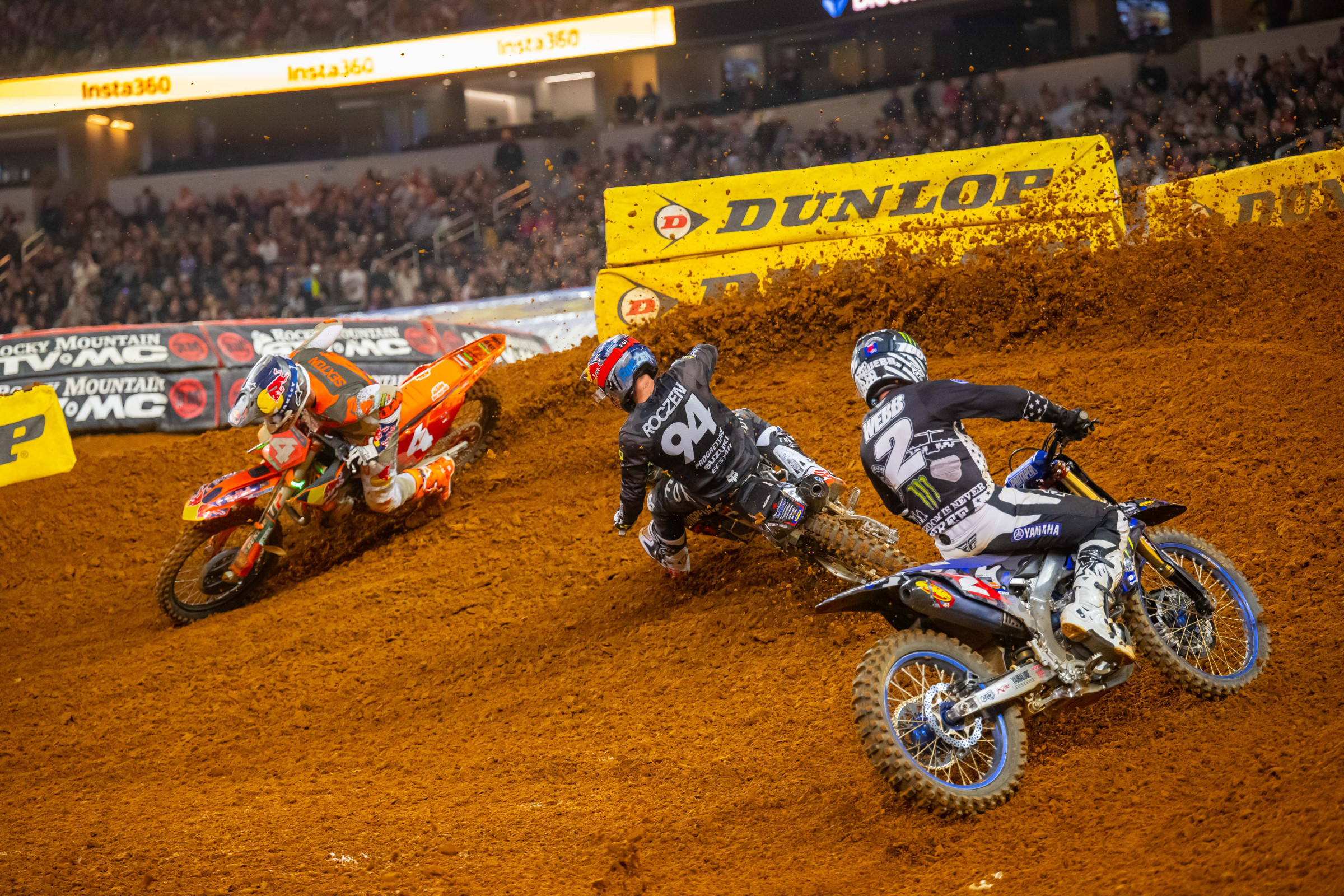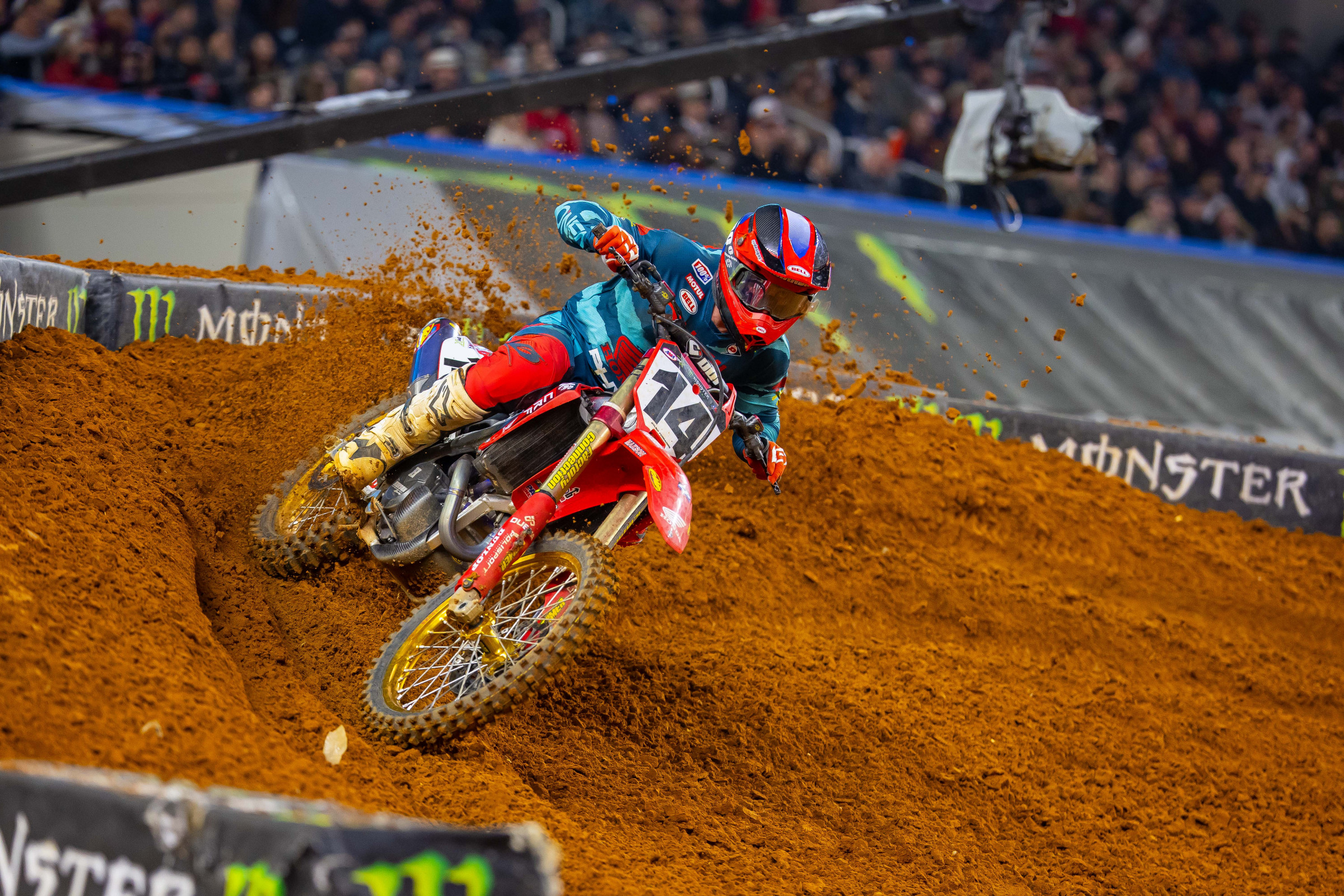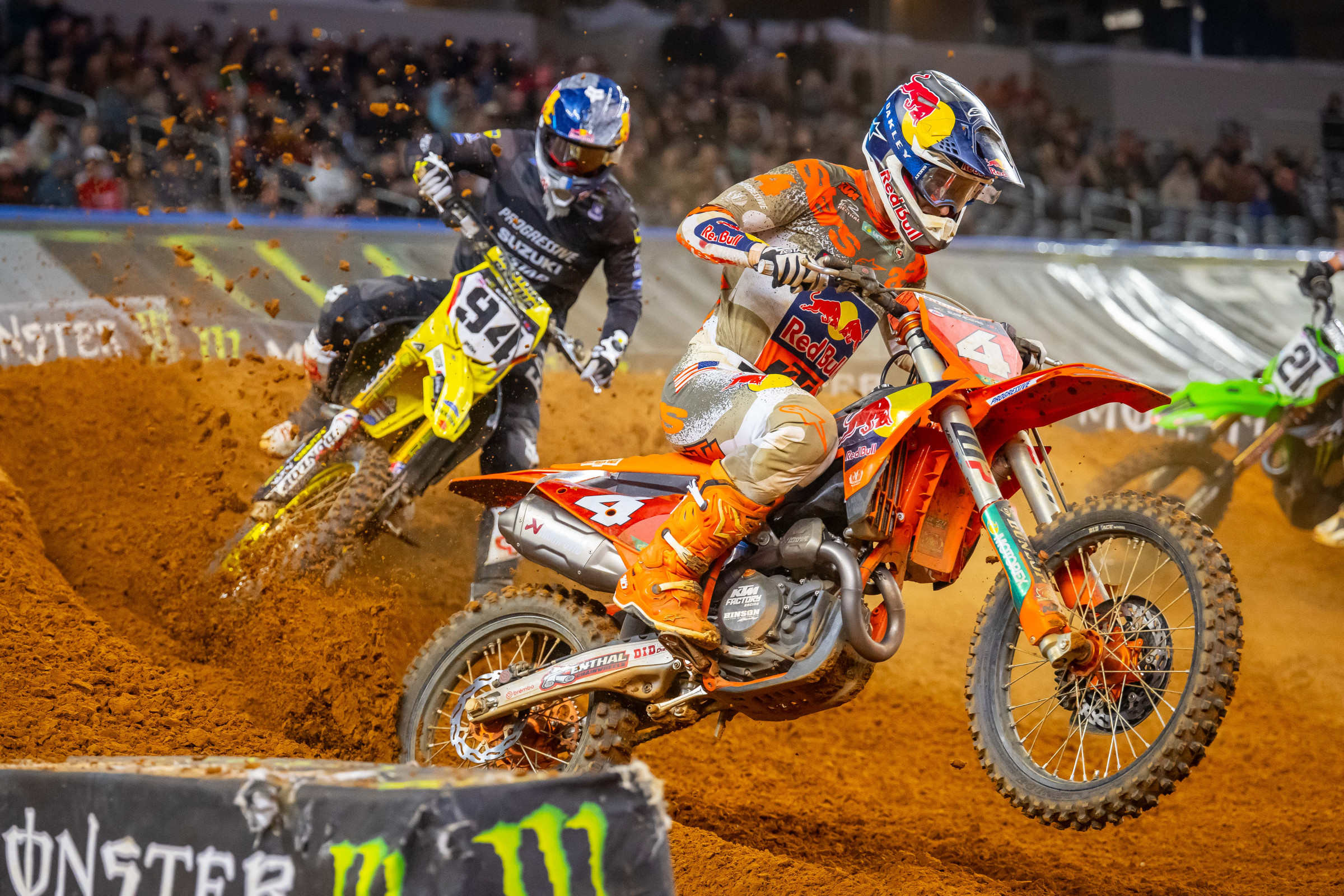The seventh round of the Monster Energy AMA Supercross series took place on Saturday in Arlington, Texas, and what a round it was! The Triple Crown format delivered a whole lot of close and tumultuous racing, and when the roost had settled we were left staring at each other wondering what had just transpired. To get answers, we sent former pro and NBC reporter, Jason Thomas, some questions in the hopes of gaining a bit more insight into the craziness that was Arlington.
Over the course of the day several riders described the dirt has having grip, until you dug down and it the harder base. What’s it like riding this teeter totter of traction?
It’s very tricky. The dirt “wants” you to be aggressive, as it has loose dirt on top that invites riders to grab a handful of throttle and accelerate from. The base is much harder though. When rear tires dug into the loose clay and met the harder base, wheel spin began. Further, the front tire was pushing quite a bit, especially early in the races after track work. The 250 riders were losing grip with the front tire several times a lap and having to catch themselves with a foot dab. There is often a lot of talk about “setup,” but if you can get your motorcycle to feel planted and get solid traction, it’s a big benefit. Justin Cooper and Chase Sexton both looked like they were on the front end of this aspect.
The rhythm lanes didn’t seem like they offered much variation. What sections offered the best opportunity to make up time?
Most riders were using the same options but riders were able to make up time by carrying more speed through the jumps and also minimizing mistakes. Often, simply missing the main rhythm was a difference maker. The 3-3 in the middle of the course was a crucial section to get right each lap. When the track is deteriorating, it can simply become a question of who can execute perfect laps time after time, versus the hero lap followed by several mistakes trying to repeat it.
The sand section was collecting riders like crazy all day. Sand is always tricky, but was there something especially treacherous about this particular section?
It was incredibly deep. That was the difference maker. It took a long time for riders to create lines that got through that sandy mess and down to something more predictable. When Shimoda and Deegan both crashed on the outside, they were victims of the track simply not being worked in yet. Once the top layer got blown off, riders could predict the traction and most got through without incident.
On the broadcast you mentioned Cole Davies, who had a couple of back-to-back mistakes, needed to slow his heart rate down. How does one go about actively lowering their heart rate while racing? Is it as simple as just breathing and slowing slightly?
When a rider makes multiple saves in a row and has close calls like that, their heart rate spikes. They get out of their normal rhythm and things feel very rushed. It’s important to slow things down and get back to the normal cadence they’ve have trained for. This can be a 10 heartbeat per minute difference, but that difference is crucial to maintain (think 175-180 versus 190+). When you hear riders say, ‘I blew up,’ this is what they mean. Their heart rate gets to an unsustainable level and they literally have to back down their pace. Riders will do sprint work on both their bicycle and motorcycle trying to up this sustainable range. Interval training is also really important in this aspect. The quicker a rider can recover from a heart rate spike and continue on with their targeted range, the better. For Davies, he just needed to smooth out and calm down so that he could slow his breathing, too. Once he got his heart rate under control, he would find rhythm again. When his heart rate is approaching 200, he is nearly hyperventilating and not getting enough oxygen which also effects decision making. There are a lot of angles to it but the most important part is consciously slowing the whole scenario down for half a lap to reset body and mind.
Jordon Smith had a horrible crash in the whoops and ended up with a punctured lung. Was there anything unusual about his crash, or was it a standard get-off in the whoops?
Smith doesn’t like to back out of things when they start to go sideways. It’s been his modus operandi since day one. He can often make it work and it allows him to push the edge. The trouble is, when it goes wrong, it goes very wrong. In this scenario, when he starts to lose traction, most riders would check up and do all things possible to save the crash (think AP7 on the first lap of race three). Jordon likes to stay committed in this dynamic and the results can be catastrophic because of it. Even if you don’t save it, when you back out, the crash at least becomes much slower and less violent. When committed, well, you see what happens. I am certainly not saying Smith is doing anything wrong, it’s just the price paid for high risk approaches. He is willing to take big risks, more than most, but the price for that risk is often tough to accept.
Haiden Deegan was on fire all night and looked more like the guy we expected to see before the season got started. Did you notice anything about him that was different in Arlington?
He did look different. I am not sure if it was the time off, the change in his training routine, different dirt, or something behind the scenes. But, he did look much more capable of working through traffic and showed a significant edge that he didn’t have at most rounds. In Glendale, he was virtually stuck where he started. He didn’t look like the fastest guy in the class. This version of Deegan was much better and clearly the fastest. This was the guy we saw last September.
Julien Beaumer dislocated his shoulder during qualifying. What kind of pain and adversity was he facing as a result?
I’m shocked they didn’t share this info with anyone, as it’s a requirement now. Let’s start there. Past that, he had to be struggling with pain and strength. There are plenty of ways to mask pain so I would guess the strength part was more of an issue in the races. His approach would change, even if subconsciously, from an all out attack to win the race to simply salvaging what he could. His practice crash was a big one so this news isn’t shocking, but it is shocking they didn’t tell anyone. I would guess a phone call is coming about that.
Chase Sexton didn’t need to pass Cooper Webb in the last 450SX main event to win the overall, yet he still sent it toward the end of the race and got into the back of Webb in a righthander. Why do you think he was going so hard when he didn’t even need the spot?
The only possible answer here is that emotion got the best of him. There is so much adrenaline going and these guys want to win. He would want to send a message to Webb that he can beat him and further, pass him late in the race, which most haven’t been able to do to the #2. That ambition got the best of him here.
If you’ll remember, I ask Ricky Carmichael during the 250 race if Deegan will make passes and move forward even though he had a five-point lead for the overall. This decision to push and go for the win is the same one that Sexton was facing. I posed the question because any crash or mistake that cost him the win would be forever judged. Deegan was able to do it without incident, Sexton lost the front end and will never, ever forget it. I understand Sexton’s motivation but managing levels of risk is what riders of their caliber are asked. Sometimes, not always, caution is the better part of valor. When and where is how the money is made.
There was more Justin Hill magic on display in Arlington. He was the fastest qualifier of the day and went 4-4-8 for fifth overall. How does one explain this? Was there just something about the track that suited Hill’s style?
There is no explaining when the best Justin Hill will show up. I’ve seen it in New Jersey, I’ve seen it in Arlington, I’ve seen it in Tampa. I cannot find a common theme for when this elite guy will make an appearance. He is a rider that needs to ‘feel it’ to be his best self. He is a unique character and I have to believe that weighs in here. Riders like Webb are robotic machines when it comes to racing. Hill has more rhythm, more soul in his riding. That nuance might be where the variance comes from. Honestly, I have no idea. I do know that when he’s on, he is a bad, bad man.







